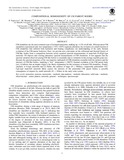Compositional homogeneity of CM parent bodies.
Metadata
Show full item recordAuthor
Vernazza, P.
Marsset, M.
Beck, P.
Binzel, R. P.
Birlan, M.
Cloutis, E. A.
DeMeo, F. E.
Dumas, C.
Hiroi, T.
Date
2016-08-10Citation
Vernazza, P., M. Marsset, P. Beck, R.P. Binzel, M. Birlan, E.A. Cloutis, F.E. DeMeo, C. Dumas, and T. Hiroi. "Compositional homogeneity of CM parent bodies." Astronomical Journal 152 (3) (2016): 54 (10 pp). DOI: 10.3847/0004-6256/152/3/54.
Abstract
CM chondrites are the most common type of hydrated meteorites, making up ∼1.5% of all falls. Whereas most CM chondrites experienced only low-temperature (∼0°C–120°C) aqueous alteration, the existence of a small fraction of CM chondrites that suffered both hydration and heating complicates our understanding of the early thermal evolution of the CM parent body(ies). Here, we provide new constraints on the collisional and thermal history of CM-like bodies from a comparison between newly acquired spectral measurements of main-belt Ch/Cgh-type asteroids (70 objects) and existing laboratory spectral measurements of CM chondrites. It first appears that the spectral variation observed among CM-like bodies is essentially due to variations in the average regolith grain size. Second, the spectral properties of the vast majority (unheated) of CM chondrites resemble both the surfaces and the interiors of CM-like bodies, implying a “low” temperature (<300°C) thermal evolution of the CM parent body (ies). It follows that an impact origin is the likely explanation for the existence of heated CM chondrites. Finally, similarly to S-type asteroids and (2) Pallas, the surfaces of large (D > 100 km)—supposedly primordial—Ch/ Cgh-type main-belt asteroids likely expose the interiors of the primordial CM parent bodies, a possible consequence of impacts by small asteroids (D < 10 km) in the early solar system.

